Physical Address
304 North Cardinal St.
Dorchester Center, MA 02124
Physical Address
304 North Cardinal St.
Dorchester Center, MA 02124
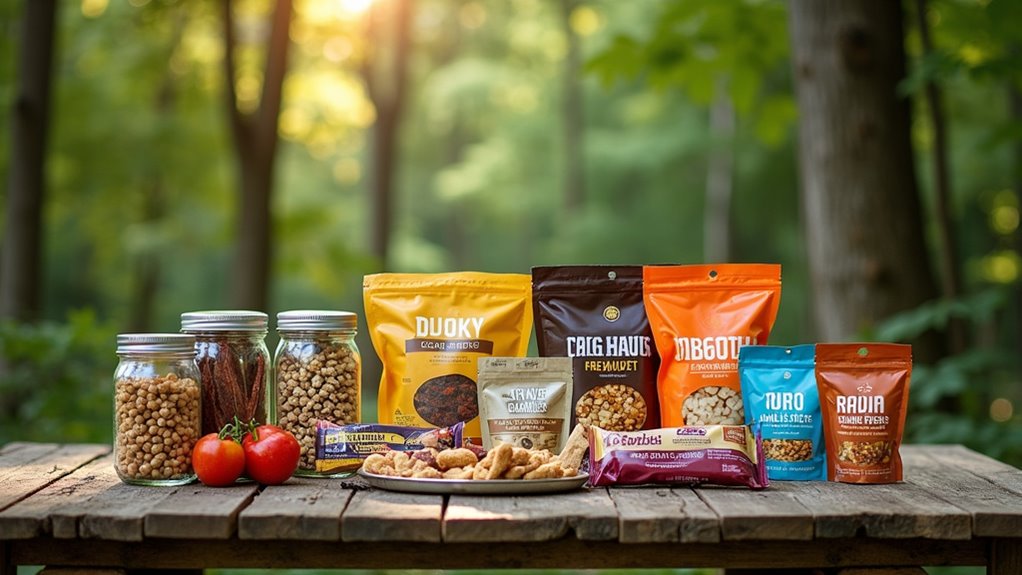
Make your outdoor adventure delicious and affordable with these 12 proven trail foods that experienced hikers swear by.
When you’re planning your next outdoor adventure, you should aim to pack foods that are lightweight, durable, and energy-rich without breaking the bank. You don’t need expensive specialty items to stay well-fed on the trail. From instant meals to protein-packed snacks, there are plenty of budget-friendly options that’ll fuel your journey. Let’s explore twelve trail-tested food choices that combine practicality with nutrition, ensuring you’re energized for every mile ahead.

The right instant meals can make or break your camping and hiking experience. You’ll find several types to choose from, including freeze-dried meals that rehydrate quickly and dehydrated options that cost less but need more prep time.
Choosing the right instant meals matters – they can elevate your outdoor adventure or leave you wishing you’d packed differently.
For maximum convenience, look for cook-in-bag meals that eliminate cleanup hassles. Active hikers need 2,600 to 3,000 calories daily to maintain energy levels. Delicious camping recipes can be a great source of inspiration for your outdoor adventures.
Mountain House and Peak Refuel lead the market with reliable options like Chicken and Dumplings or Beef Stroganoff, delivering 600+ calories per pouch.
If you’re watching your budget, consider dehydrated meals that offer good value while maintaining decent taste. Check for allergens and dietary restrictions on labels, and remember that most meals need 1-2 cups of boiling water.
You’ll get the best results by stirring thoroughly and allowing proper rehydration time.
When planning extended hikes, you’ll need energy-rich snacks that pack maximum calories into minimal weight. Look for foods providing at least 100 calories per ounce to optimize your pack load.
Trail mix combinations of nuts, seeds, and dried fruits offer quick energy boosts, while being customizable to your taste and budget. Aim to drink 16 ounces per hour while hiking to maintain proper hydration levels.
Consider packing high-fat options like nut butter pouches and PROBAR Meal Bars for sustained energy. Energy bars average 350 calories per bar, making them efficient fuel sources. Delicious camping foods can also be great options to fuel your outdoor adventures.
You can also prepare cost-effective alternatives like peanut butter-filled pretzel nuggets or whole grain bagels with hummus. For variety, mix high-carb snacks for immediate energy with protein-rich options for muscle recovery.
Dried fruit paired with dark chocolate or nuts creates an ideal balance of natural sugars and healthy fats.
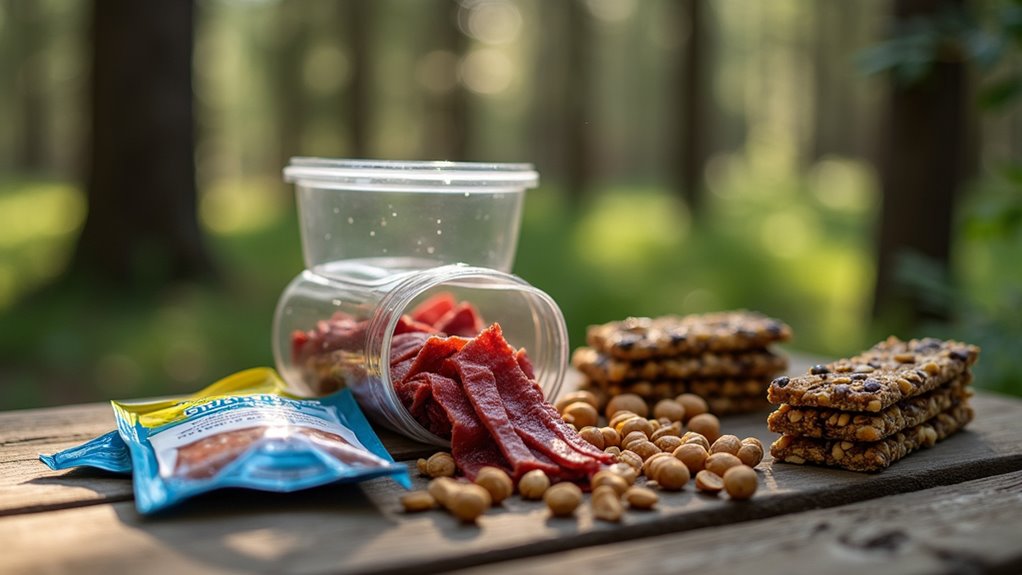
Maintaining adequate protein intake during outdoor adventures requires strategic food choices that combine durability with nutritional value.
Smart packing for outdoor protein means choosing foods that last long and pack a nutritional punch for your wilderness journey.
You’ll find excellent protein sources in canned fish, chicken, and tuna, which offer concentrated nutrition in portable packages. For lighter options, consider turkey or beef jerky, which provide about 10 grams of protein per ounce. Experts recommend consuming 2 grams per kilogram of body weight in protein when hiking to support muscle function and recovery.
Don’t overlook versatile protein-rich spreads like peanut butter and other nut butters, which you can pair with crackers or bread. Delicious camping meals can also provide a substantial protein boost for your outdoor adventures.
Dehydrated meals, including powdered eggs and Mountain House options, give you substantial protein without weighing down your pack. For quick energy, pack protein bars or meal replacement shakes.
You can also boost your protein intake with durable hard cheeses and shelf-stable salami, which don’t require refrigeration for short trips.
Starting your day on the trail requires breakfast options that balance convenience with sustenance.
You’ll find several quick solutions that won’t slow down your morning routine. Mix chia seeds with water or nut milk for a no-cook pudding, or prepare hot granola using a Flash Cooking System topped with dried fruits for extra energy. The vitamin-dense vegetables in breakfast quesadillas provide sustained energy for outdoor activities.
For protein-rich starts, load up a bagel with cream cheese and salmon, or whip up a mountain breakfast skillet with eggs and vegetables. Delicious camping recipes can also include savory breakfast options like breakfast burritos or frittatas.
If you’re planning an early departure, try caffeinated oatmeal or cold power oats that you can prepare the night before. When cooking isn’t possible, pack cereal with powdered milk or create an avocado spread for bread.
These options give you the fuel you need while keeping preparation time minimal.
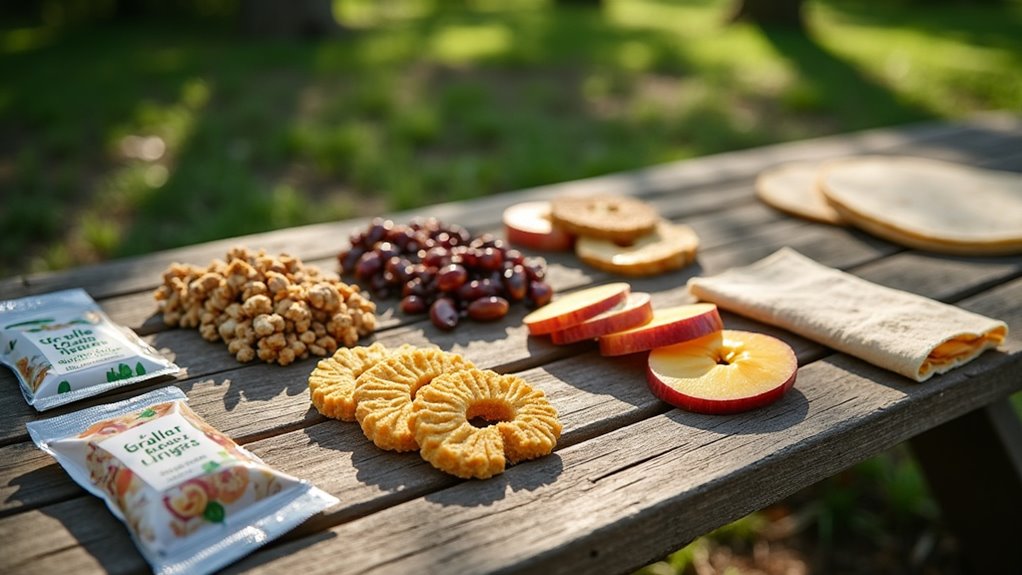
Packing lightweight lunch options can make or break your backpacking experience. You should aim to focus on nutrient-dense foods that won’t weigh down your pack or spoil quickly on the trail.
Consider no-cook options like tuna sachets with crackers or individual cheese wedges for protein-rich meals. Pre-packed hummus with flatbread offers a filling plant-based alternative. Combining ingredients in single portion bags helps maximize space in your backpack while keeping meals organized.
For minimal prep meals, try dehydrated pasta salads or homemade instant soups – just add water and you’re set. Don’t forget shelf-stable spreads like peanut butter packets or single-serve guacamole cups. Simple and Delicious Camping Meal Ideas to Try can provide more inspiration for your backpacking menu.
If you’re looking to maximize calories while minimizing weight, pack a custom trail mix with nuts, dried fruit, and seeds. Ready-to-eat protein bars and jerky also provide quick energy without requiring preparation time.
Whether you’re hiking through challenging terrain or setting up camp, proper hydration can make the difference between an enjoyable outdoor experience and a dangerous situation.
You’ll need about 0.5 liters per hour during moderate activity, but hot weather and high altitudes require more. Watch for signs like dizziness and headache which indicate dehydration is setting in.
Don’t wait until you’re thirsty to drink – that’s already too late. Start your day with at least 0.5 liters of water and refill at every reliable water source. Refreshing alternatives to water can also help quench your thirst anytime.
Stay ahead of thirst – begin each morning with a half-liter and keep your water topped up throughout your adventure.
Always treat natural water by boiling, filtering, or using purification tablets. Consider adding electrolyte powders to your water during intense activity to replace lost salts.
While hydration packs are convenient, they add weight. Instead, opt for lightweight bottles or collapsible reservoirs, and plan your route around water sources to minimize carried weight.
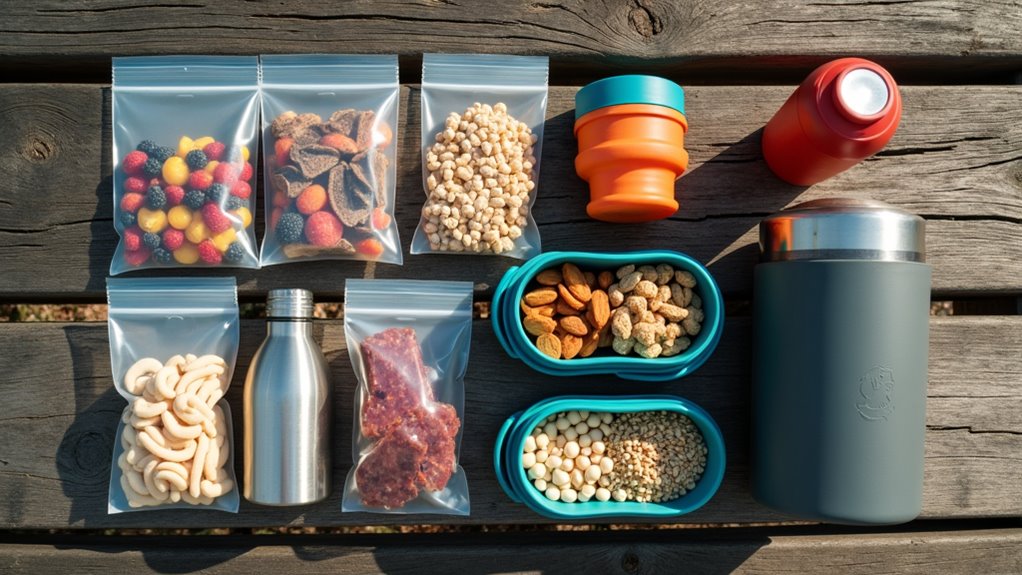
Proper food storage makes the difference between a successful outdoor adventure and a miserable experience plagued by spoiled meals or unwanted wildlife encounters.
When camping at designated sites, always store in bear boxes if provided by the campground. You’ll need to invest in hard-sided bear canisters or scent-proof bags for backcountry trips, keeping them at least 100 yards from your sleeping area. Proper food handling is crucial to prevent foodborne illnesses.
Pack your meals in reverse order and pre-portion them to save space and reduce waste. Use airtight plastic containers to keep food fresh, and avoid glass that might break.
For perishables, pack a cooler with block ice or frozen jugs, storing it in the shade. Keep raw meats separate from ready-to-eat foods.
You’ll maximize space by choosing collapsible containers and removing excess packaging before your trip. Remember to label everything clearly for easy identification during your adventure.
When planning outdoor adventures, no-cook meals offer a practical solution that’ll save you time, weight, and hassle on the trail. You’ll find plenty of satisfying options for every meal of the day.
Start your morning with a yogurt parfait or overnight oats prepared the evening before. For an extra boost, add nuts and chia seeds to enhance nutrition. For lunch, pack easy-to-assemble pita wraps or sandwiches with your favorite cold cuts and cheese.
Keep your energy up between meals with protein-rich snacks like jerky, energy balls, or granola bars. Delicious no-cook recipes can also be great for camping and hiking trips.
When dinner time arrives, you can create filling meals using canned goods, ready-to-eat options, or simple combinations like hummus with veggies. Remember to prep what you can at home and pack lightweight, fresh ingredients in reusable containers. You’ll reduce waste while ensuring nutritious meals throughout your outdoor adventure.
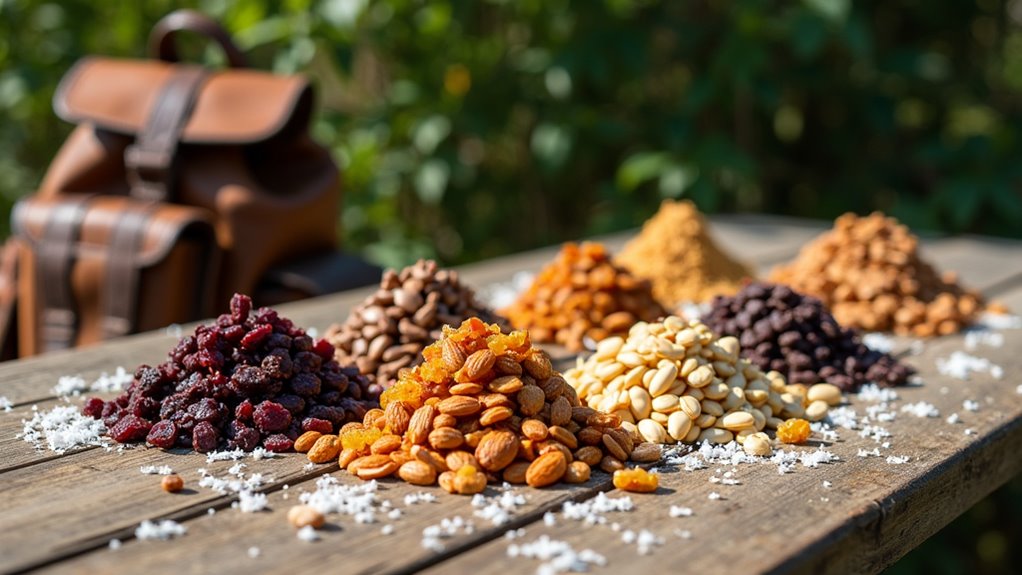
Creating your own trail mix offers a cost-effective way to fuel outdoor adventures while maintaining control over ingredients and portions.
You’ll get the best results by following a 2:1:½ ratio of nuts, dried fruit, and seeds. Choose raw, unsalted nuts like almonds, walnuts, or cashews as your base, then add nutrient-rich seeds such as pumpkin or sunflower seeds. Essential Cooking Tips for Your Next Camping Adventure can provide additional guidance on food preparation for camping.
For ideal nutrition and taste, mix in dried fruits for quick energy and essential vitamins. Store properly in containers to maintain freshness for up to one month. You can toast nuts and seeds at home to enhance flavor while controlling salt and sweetener levels.
If you’re planning intense activities, include a pinch of salt for electrolyte balance. Consider adding small amounts of treats like dark chocolate chips or yogurt-covered raisins for an energy boost, but keep portions modest to maintain nutritional value.
Dried and dehydrated foods offer the perfect solution for lightweight, nutritious meals on the trail while keeping your budget in check.
You’ll find a wide variety of options, from fruits and vegetables to meats and complete meals, that you can either purchase commercially or prepare at home using a dehydrator.
Your best value comes from dehydrating foods yourself. You can buy ingredients in bulk, control portions, and reduce packaging waste. For optimal results, store your dehydrated meals in airtight containers to prevent moisture absorption.
While some water-soluble vitamins decrease during the drying process, proteins, carbohydrates, and fiber remain intact. You’ll appreciate how these foods pack easily, require minimal preparation, and provide the calories needed for strenuous hikes.
Simply add hot water, wait a few minutes, and you’ve got a satisfying meal without carrying excess weight or spending a fortune.
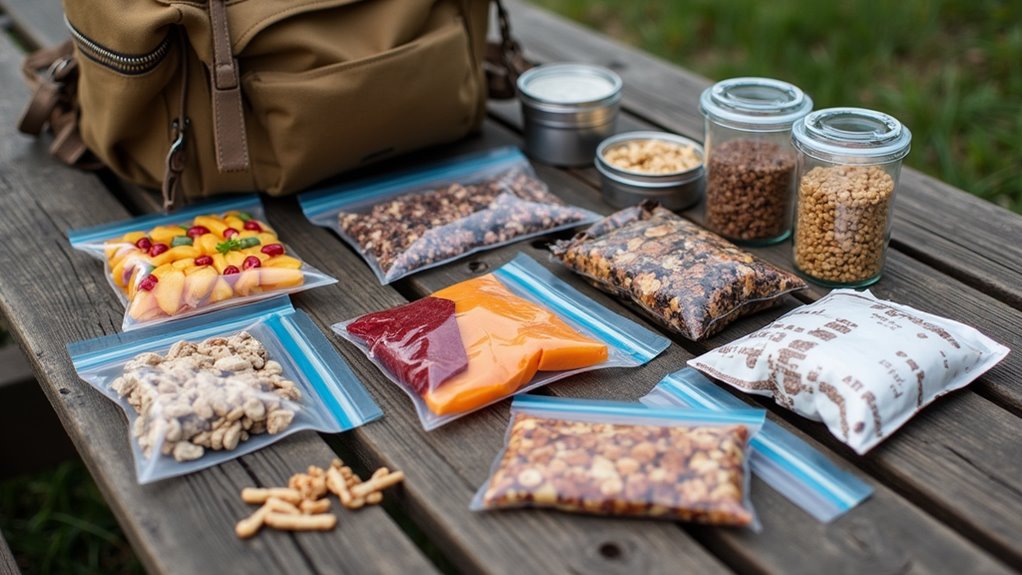
While dried foods serve well in controlled conditions, unpredictable weather on the trail demands extra consideration for your food choices. You should aim to pack freeze-dried meals that only need hot water and can last up to 30 years, along with lightweight soups that provide warmth and essential electrolytes. Mountain House meals are widely available and offer a reliable 30-year shelf life for long-term storage.
For perishables, maintain temperatures below 40°F using coolers and frozen gel packs, and pack in reverse order for easier access. Store your food in bear-proof containers or metal boxes when provided at campgrounds. Camping fridges can also be a useful investment to keep food fresh for longer periods.
Consider stable alternatives like hard cheeses, cured meats, and vacuum-sealed nut butters that can withstand variable conditions. Energy bars and trail mixes offer reliable nutrition without special storage needs.
Keep everything in waterproof, sealed containers to protect against rain and humidity while maintaining quick access to your supplies.
To maintain energy during strenuous outdoor activities, you’ll need high-calorie foods that pack maximum nutrition into minimal space. Focus on dried fruits, nuts, and trail mix, which deliver 100-160 calories per ounce.
Smart trail nutrition means packing dense, high-calorie foods like dried fruits and nuts that deliver maximum energy with minimal weight.
Pack energy bars that provide 200-250 calories each, perfect for quick refueling on the trail. You can enhance meals with full-fat milk powder for additional calories and nutrition.
For protein-rich options, consider beef jerky, instant protein powder, and dried legumes. You’ll find freeze-dried meals and instant grains particularly convenient, while nut butters serve as excellent calorie-dense spreads.
Don’t overlook healthy fats from almonds, sunflower seeds, and cheese – they’re essential for sustained energy.
Choose lightweight, shelf-stable items like instant mashed potatoes and ramen noodles when you need quick, filling meals. These options won’t weigh down your pack but will keep you energized throughout your adventure.
Your trail food choices can make or break your outdoor adventure like a compass guides your journey. Pack smart by combining lightweight, calorie-dense options that won’t drain your wallet. Mix freeze-dried meals with no-cook alternatives, and don’t forget energy-rich snacks for quick boosts. With these budget-friendly food strategies, you’ll stay fueled and ready for whatever the wilderness throws your way.